Profile: Cornelia Seckel
By Raymond J. Steiner
ART TIMES March/ April 2012
For the past 35 years, I’ve been writing profiles of notable people — painters, sculptors, musicians, conductors, singers, playwrights — even a mime — but until now, never a publisher. This one has been long overdue…
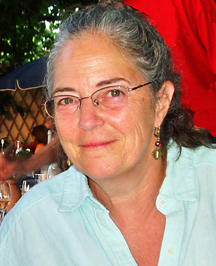 Cornelia Seckel Cornelia Seckel |
AT THE AGE of four, Cornelia Seckel announced to her mother — and the world — her then and future stance: confined to bed with chicken pox, she said to her mother in no uncertain terms, “Dammit! I want to go outside!” Bucking the odds seems to have been her modus operandi from the very beginning — a determined and confident risk-taker, her parents had long recognized — and advised others — that she was a self-reliant, headstrong challenger from the very beginning. Raised by socially-conscious and community-active parents in Queens, New York, she learned early on to direct her focus and interests toward improving the world — so much so, in fact, that her parents (her father a lawyer, her mother once a legal secretary and then teacher) were often taken aback by her precociousness. The oldest of four children, she “took charge” early on, directing not only her younger siblings, but often — too often, according to them — her parents as well. Since the day she demanded to “dammit” be let out, the word “No” would not be allowed as a deterrent to whatever path she would choose to follow.
She carried her incipient interests in furthering the quality of life into her school years, taking courses in a variety of both education and liberal arts programs through her college years — a B.A. in Speech Education at Queens College, CUNY and an M.A. in psychology and Curriculum Development at Michigan State University — teaching speech correction and English as a second language at Grover Cleveland High School in Bedford Stuyvesant (between Brooklyn and Queens) and English, Literature, Speech, Dramatics, Reading, Communication Skills, and Life and Job Survival Skills at Sexton High School in Lansing Michigan. Although married by the time she was teaching in Michigan, helping to put her husband through graduate school, Cornelia took on extra-curricular activities such as volunteering with a substance abuse prevention agency (S.T.R.I.D.E.) and working at the Listening Ear Crisis Intervention Center doing counseling, training of new volunteers, and maintaining the resource and reference files.
Her marriage ended in 1976, catapulting her into a larger world of different problems and cultures to face. After backpacking through Europe, she returned to the States and, living out of her Volkswagen station wagon, began to gather deeper insights into both herself and a society that was just coming out of the hippie philosophy of free love, free living and free choices. Although “peace and love” were the call-words of young people criss-crossing the country, she soon discovered the dark side of freedom when it degenerates into licentiousness. Driving to a rainbow gathering of “love and peace” in Arizona’s open spaces, she was raped by two men who appeared to be fellow travelers. Though the assault took its toll on her psyche, Cornelia Seckel was made of sterner stuff; she escaped from her assailants after breaking the knife they held on her with her bare hands, drove to the nearest police station and reported the crime. Not willing to leave Arizona until she had testified at their trial to see them incarcerated, she then decided to head her Volkswagen back East, trusting to her inner resources and a life of both learning and teaching to get her through and past the ordeal. While visiting Woodstock, New York exploring new places to live, the axle of her car broke and she knew she had come to the end of her travels. Here she would put down roots and fortified with new resolve, settle down to new commitments, new friends, and new community projects to which she could add her now considerable experience and knowledge. Armed with a world of new understanding, her rape now a carefully and deliberately contained “life lesson” that she would not allow to undermine her innate trust in people, she scouted her new environs for ways to apply her skills, her knowledge, her self.
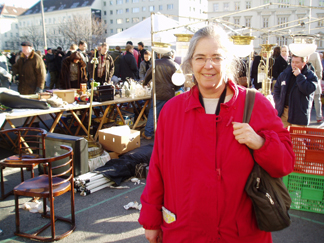 Cornelia at a market in Budapest 2005 Cornelia at a market in Budapest 2005 |
Taking a job as a Career Counselor at the Ulster County Chamber of Commerce, provided her the stability and wherewithal to make it possible for her to purchase an old country farmhouse a few miles outside of Woodstock, where she could wait, as she puts it, “for a real partner to show up in my life”. Now, on her very own 2-acre plot of land where she could indulge to her heart’s content in her love of gardening, she could really “put down roots”. As part of her job at the Chamber, she became part of a group that set about designing a program to provide career counseling, direction, information, resources and opportunities for students. Called the “Shadowing Program”, Cornelia soon became the Director (The Shadow Lady” to the students) and had an office at the Kingston High School where she matched students with professionals that they could “shadow” in order to learn more about the career they were considering after graduation. It was during this time that she designed, developed, and implemented a “Career Day” that quickly became a statewide model. It was also at Kingston High School that, in 1980, she found and married her “real partner”, Raymond J. Steiner, an English teacher who had a classroom directly across the hall from her office.
Although the job provided her an income, it was far from satisfactory insofar as utilizing all of her hard-won skills and she was soon involved “after hours” in several community organizations. Though she found outlets for her energies by volunteering for Family of Woodstock, a Crisis Intervention Center (where she served on shift work, training new volunteers, developing training programs, and on various Board positions), as a spokesperson for CHILD FIND and as a national consultant to Friends of CHILD FIND (both organizations committed to locating abducted children), as well as founding the National Organization of Women (NOW) Chapter in Ulster County, serve two years as Board Member of the Women’s Studio Workshop, serve as a member of the Drug and Alcohol Abuse sub committee of the Human Relations Committee of Ulster County Community Services Board and — finally — run for County Legislator, canvassing the county for votes (being a woman, a Democrat, and a Jew, pretty well excluded her from holding a political office in a largely Republican Conservative milieu), she still felt her talents, expertise and energy to be underused.
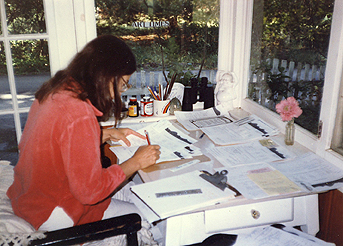 Cornelia laying working on the first issue of ART TIMES, Cornelia laying working on the first issue of ART TIMES, July 1984 |
When not applying herself to making her mark on society, Cornelia was also a hard player — dedicated to get as much out of her “down” time as she was at getting down to business. Catching a 6’2” sailfish at the age of 14 — the only one on board that day who made such a haul — set her on a path of deep-sea fishing that she continues to this day. Part of a group of women who “hit the briny” as often as they can, Cornelia has garnered awards and trophies that — along with her mounted sailfish — adorn her office. If she can’t fish, then you’ll find her in her garden, an 80’ by 80’ plot that reaps her not only strawberries, asparagus, raspberries along with whatever she plants each spring, but a peace of mind and a place to “let it all go”.
It would be her husband’s desire to leave teaching to become a full-time writer that would serve as the final piece in the puzzle of her search to realize her full potential. Finding himself dissatisfied with the handling of his free-lance writing by other editors and publishers, he brought his problem to Cornelia who, taking her own Career Counseling to heart, and, true to her four-year-old self, “took charge.” One can almost hear the wheels turning in her mind: “Dammit! I want to …!” This time, however, it was to methodically and determinedly set out to create not only a socially conscious product that would allow her to follow her own vision of an enriched and satisfaction-filled future, but also a way to solve her husband’s problem. In 1984, Cornelia Seckel created a vehicle in which to stretch their talents to the utmost — she and Raymond co-founded ART TIMES, a literary journal and resource for the fine and performing arts — a decision that, with Cornelia at the helm, took little time in its inception, its planning, and in its fruition.
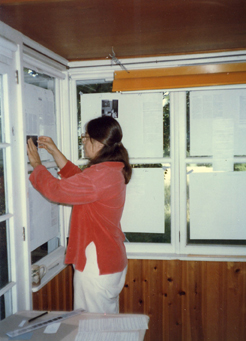 Cornelia laying out the first issue of Cornelia laying out the first issue ofART TIMES, July 1984 |
Knowing that Woodstock, nestled in the Hudson Valley/Catskill Mountain Region, was an arts-rich environment since the early 1900’s, she first had to learn why the area had no local publication that served that community. She had learned that there were several attempts at such a magazine/journal over the years, but that each had failed because there was no controlling vision that oversaw the project. Too often such endeavors were run by not-for-profit organizations that answered to a board of overseers. The first step, then, was to create a corporation with herself as CEO (the person with the vision and the final say-so); Raymond would serve as Vice-President. In early May of 1984, she went out into the community to search out other publishers to learn all of the ins-and-outs of the business. She had attended an “All Women in Business” conference in Poughkeepsie and discovered many ready-to-help conferees, particularly one, Merna Popper, publisher of Women’s News in Westchester, County. Beginning her rounds that day at the conference, she had begun with “I’m thinking about…” and before she was halfway through was declaring, “I am going to publish an arts magazine”. A trip to Merna’s business for a crash-course in how to put a newspaper together and a follow-up the next day at Walden Printing in Walden, NY to learn what they needed in order to fulfill her vision was all it took. Now it was time to fully bloom.
In spite of naysayers — and there were many at the outset (they didn’t know that Cornelia could not hear the word “No”) —ART TIMES, Volume 1, Number 1, was born in August 1984 with Cornelia as Publisher (finally running her own show), and Raymond, as Editor (who would now have control over how his writing would be handled) with 10,000 issues on the way. Once launched, Cornelia entertained no thoughts of failure, a confidence quickly confirmed by her selling enough advertising to pay for the costs of the first (mocked-up) issue, with each year (soon up to 26,000 issues per month) following the same pattern. Almost immediately, her vision, her net-working skills and drive led to a one-of-a-kind publication that gained attention not only locally, but eventually globally, her current online presence attracting nearly 600 visitors a day, a million+ “hits” a year.
Cornelia describes her publication as having “two personalities: my nature as a resource person with business skills and Raymond’s philosophical and literary background.” ART TIMES addresses all of the arts, serving as a resource for both established and upcoming artists, with an Opportunity Column and a Calendar of Events that includes hundreds of activities and venues in the Northeast Region of the U.S. Essays on the arts by hand-picked writers, poetry and short fiction have been staples since its beginning. Subscriptions are mailed across the country and, indeed, across oceans with copies going to England, Germany, Italy, Russia, France and Russia. The publication’s focus has been “the long view”, avoiding coverage of what has been called “the flavor of the month.” Indeed, Cornelia has seen many publications devoted to “cutting-edge” art fall by the wayside since ART TIMES’s near thirty-year presence, simply because what may be “hot” this year may not be so the following year. In effect, such publications almost invite failure since their reason-for-being is so short-lived. So successful has been the editorial policy of ART TIMES’s “long view” and high literary standards that it has maintained a devoted readership both here and abroad, ensuring many years to come.
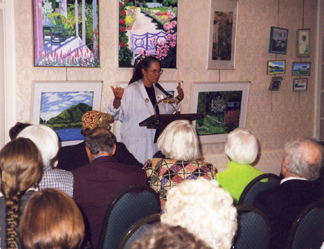 Cornelia speaking about the importance of buying original art at the Jewish Federation of Ulster County’s Cornelia speaking about the importance of buying original art at the Jewish Federation of Ulster County’s Fall For Art Cocktail party and art sale |
As her publication flourished, so did Cornelia’s reputation as a “do-er” who knew how to get things accomplished — she became the “go-to” person for a host of groups and organizations that wanted to tap into her talents as a resource person and networker. Early on in her publication’s history, she had a weekly segment on the WAMC Public Radio Network called “Culturally Speaking” (now incorporated into each online and printed issue) in which she spoke about organizations, exhibits, plays, concerts — in short, any cultural institution or event — that crossed her desk. Her efforts did not go unnoticed, and soon she was invited to cover cultural events not only across the States, but also in places like Singapore, Canada (Quebec, Montreal), China (Beijing, Shanghai), Germany (Cologne, Berlin), Italy (Rome), Belgium (Leuven), and even to attend the International Cultural Summit at Versailles, France. It would not be long before she was asked to serve on Arts-Related and/or Advisory Boards, hold Honorary Memberships in others, and serve as juror or judge of art exhibits throughout the Northeast of New York State — and beyond. In the 10th year of ART TIMES, she received an Executive Chamber Citation from then Governor of New York Mario Cuomo. This has been followed by recognition, acclaim and awards over the years from such organizations as All Women in Business, Ltd, Pastel Society of America, National Association of Women Artists (NAWA), Ulster County Chamber of Commerce, and the Movado Children’s Foundation. Recognizing the value of such acclamations, she began her own Art Times’ Cultural Achievement Awards, awarding them to deserving organizations for several years. For the past four years, she has served as co-chair of the Woodstock Arts Fair.
An Honorary Vice President and Board membere of the National Association of Women Artists (NAWA), The Salmagundi Club, the Catharine Lorillard Wolfe Art Club, Artist’s Fellowship, Inc., ArtTable, Inc., Pen & Brush, Co-founder and member of Alliance of Women Entrepreneurs (AWE), National Organization for Women (NOW), the American Association of University Women (AAUW), and the Society of the Silurians, Cornelia Seckel has more than proved her determination, her abilities and, most of all, to disregard the word “no”.
